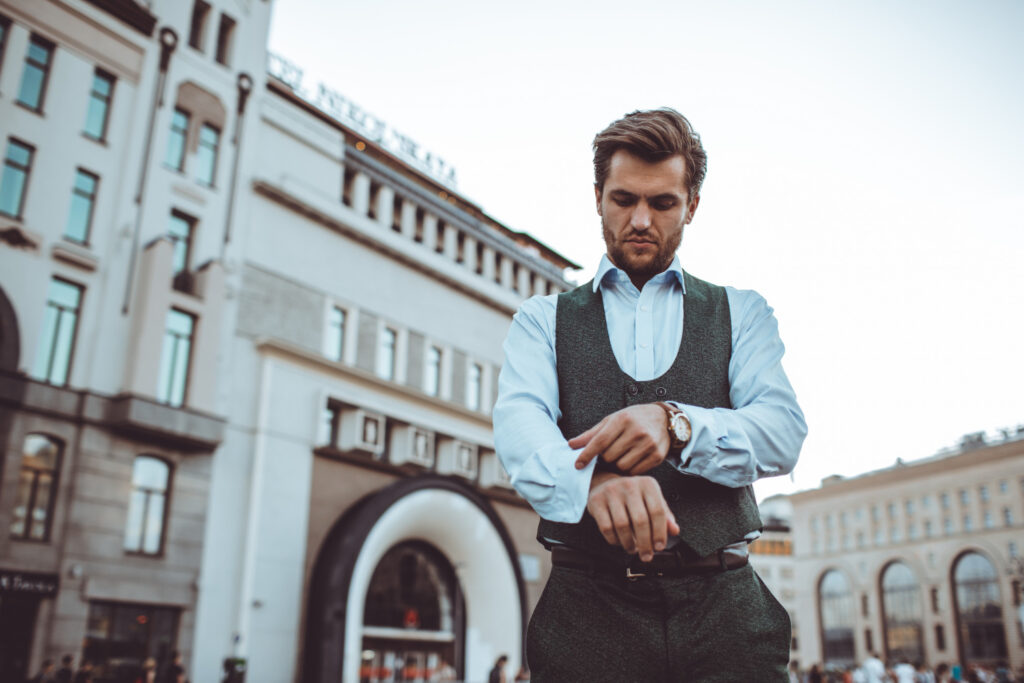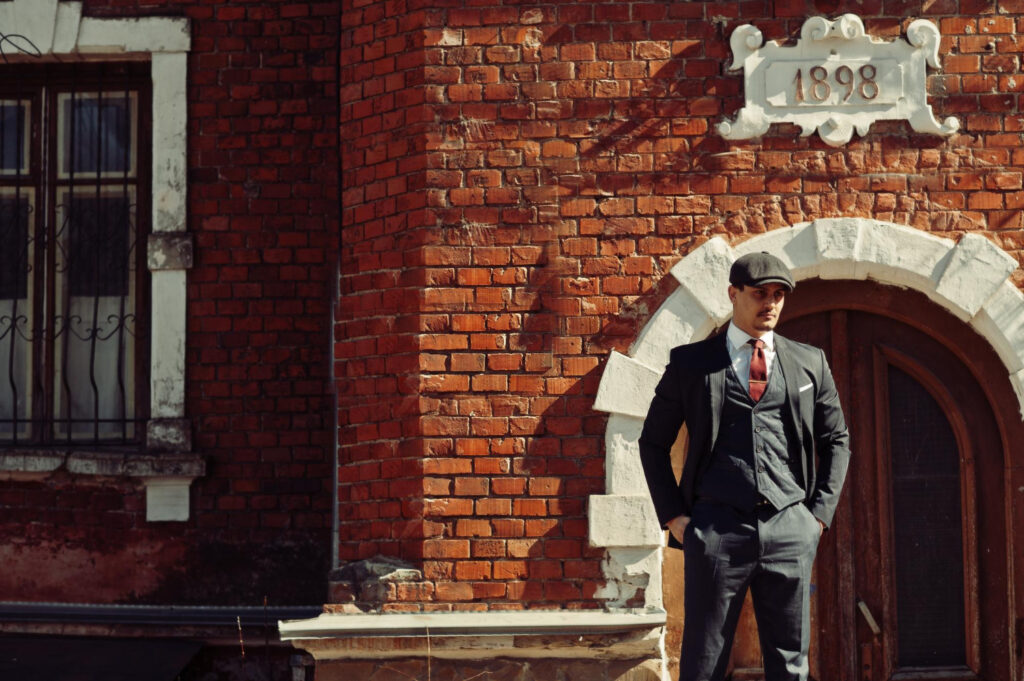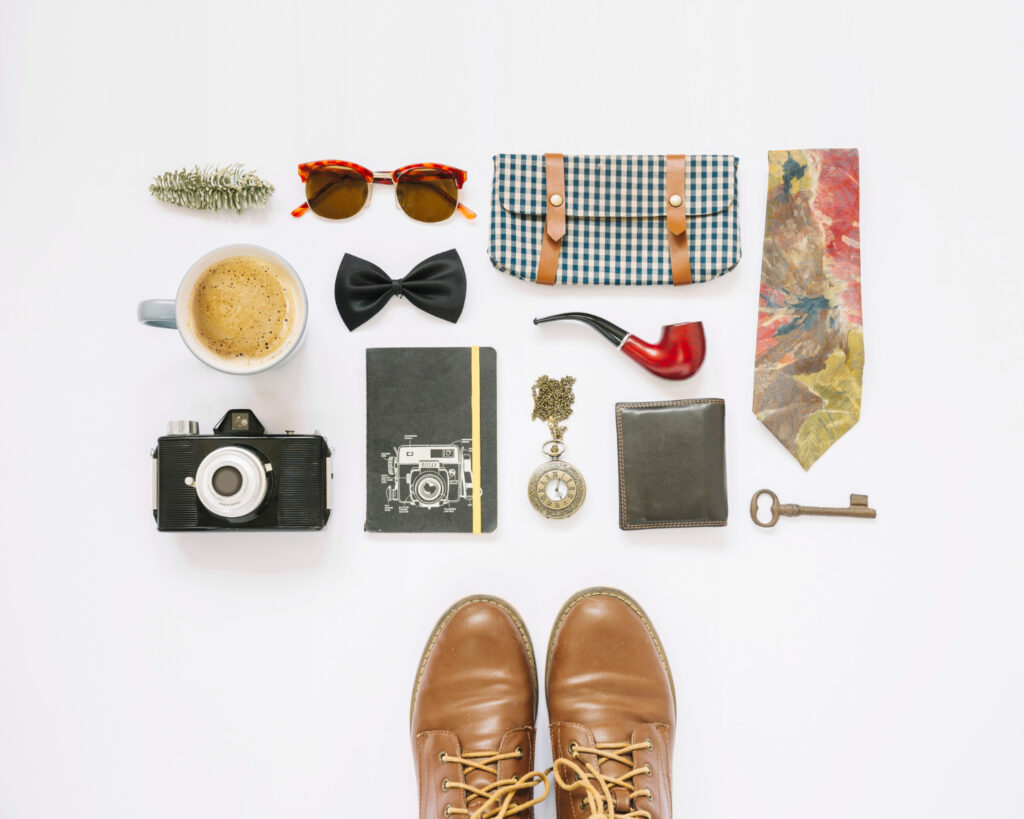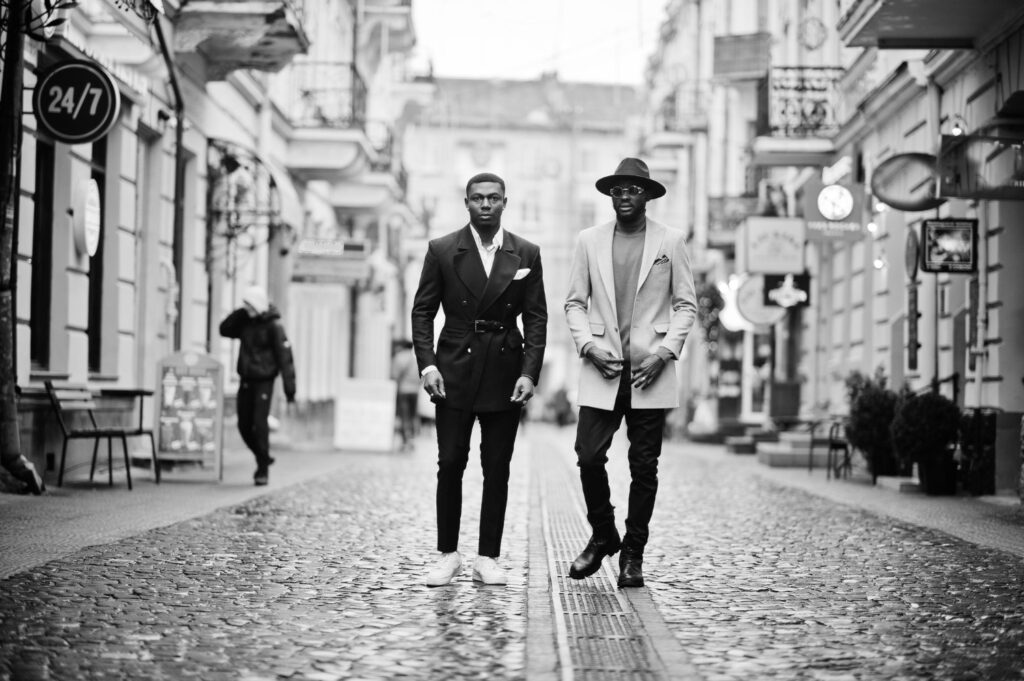A significant turning point in the Roaring 20s Men’s Fashion, which brought in an upward style trend that continues today. Men’s clothing became a medium for self-expression as a spirit of reinvention and joie de vivre overtook the world as the gloomy shadows of World War I faded.
Tailoring Takes Center Stage
The suit was the mainstay of men’s fashion in the 1920s and saw a significant evolution. The stiff, buttoned-up looks of the past gave way to a more streamlined, slimmer design. Fitted jackets with peaked or notched lapels were a staple of suits; they were frequently double-breasted and exuded an easy sophistication.
Men started to embrace the comfort and versatility of wool tweeds, flannels, and mohair, which caused a change in the materials as well. While still permitting some flexibility and movement, these thicker, more substantial materials gave the clothes a sense of weight and gravity.
Accessorizing with Flair
Without the cautiously chosen accessories that provided the finishing touch of sartorial bluster, no 1920s suit was complete. Particularly, hats came to characterize the fashion of the day; fedoras, bowlers, and flat caps all contributed a distinctly sophisticated vibe.
Smaller accents that let men show off their unique sense of style, such as collar pins, tie clips, and pocket squares, were just as significant. In addition to being functional, these accessories represented the wearer’s admiration of exquisite craftsmanship and attention to detail.
Including 20s Items in your Modern Style Closet
Take into account the following vital accessories from the 1920s to add the look to your current wardrobe:
Jackets: Influencing modern business wear, men’s double-breasted 1920s jackets featured broader lapels, and a lower buttoning position, and were composed of harder materials like wool.
Shirts: Towards the end of the decade, pastel colors became popular. Shirts were either solid colored or had contrasting vertical stripes. Turndown collars and single-cuff cotton shirts were in style.
Pants: By the end of the 1920s, tapered suit pants had replaced the earlier flat-fronted, fuller-cut pants of the beginning of the decade. Plaid, tweed, and striped patterns gained popularity.
Accessory: ideas for an authentic 1920s retro look include fringe, beads, drop waist dresses, headbands, armbands, and pearls.
Capsule Wardrobe: Putting together a 1920s-inspired capsule wardrobe can be effective and adaptable. Using a suit as the base, you can mix and match skirts, blouses, and accessories to fit a variety of events.
You can effortlessly incorporate the timeless elegance of the 1920s into your present closet by focusing on certain characteristics, such as jacket styles, shirt designs, trouser shapes, and accessories that are typical of that era.

How Did Men’s Fashion Change In The 1920s?
Men’s fashion changed drastically in the 1920s, moving from the more stiff and robust styles of the decade before to a more loose-fitting and informal aesthetic. Men’s fashion saw several significant shifts in the 1920s, including:
Evolution of Formal Dress: In contrast to the rigid style of the previous decade, men’s formal and evening dress in the 1920s saw a move towards more form-fitting, tailored ensembles with softly sloping shoulders and cuffed trousers.
Trend for Casual Dressing: A more carefree attitude to dressing was reflected in the rise in popularity of more relaxed menswear, such as jumpers, caps, wide-leg or baggy trousers like plus-fours, sweaters, and other accessories.
Casual Shirts and Pants: Even for individuals who did not participate in sports, casual pants went from high-waisted, straight-legged, and tapered-at-the-bottom styles to broader and baggier options like knickerbockers and jeans. Casual shirts were frequently undone and had brighter or striped prints.
Men’s grooming practices also changed in the 1920s: wavier hair was preferred to have a slightly disheveled look, sideburns were trimmed higher, and medium-length hair was arranged in comb-overs or slicked back. Opinions on facial hair shifted, favoring a more clean-shaven appearance.
All things considered, the 1920s were a pivotal time in menswear history, with a shift towards more relaxed, easygoing, and expressive looks that set the stage for contemporary menswear trends.

Myths Regarding Men’s Clothing in the 1920s
The misconception that men’s fashion from the 1920s was exclusively about extravagance and luxury is a common one. In actuality, though, the Roaring Twenties’ fashion also embraced comfort, elegance, and a hint of defiance in addition to being stylish. The era signaled a dramatic change from the stiff and formal appearances of earlier decades to more approachable and laid-back looks.
Contrary to popular belief, men’s fashion of the 1920s placed a strong emphasis on striking a balance between comfort and sophistication. Loosely fitted suits allowed for greater freedom of movement, and textiles experimented with textures and hues outside of the conventional black and grey palette. The goal was to celebrate success, advancement, and uniqueness via attire that exuded freedom and happiness.
Grooming trends of the 1920s also focused on projecting a sophisticated and tasteful image of oneself in addition to looking well. Men’s hairstyles of the time, such as slicked-back looks produced with pomade or brilliantine, demonstrated exacting grooming standards that emanated refinement and control.
Menswear in the 1920s was, in essence, revolutionary because it blended comfort with elegance, eliminating the myth that the decade was only about extravagance and luxury. It also helped to shape current menswear styles.
Accessories for Men in the 1920s
In the 1920s, men’s accessories had a major role in determining the fashion trends of the day. The following important accessories were in style in the 1920s:
Canes: Throughout the 1920s, canes were not only useful but also stylish decorations. They were frequently lavishly embellished and came in a variety of shapes and sizes.
Pocket Squares: Printed silk alternatives, as opposed to simple white cotton or linen squares, have become increasingly popular, enabling men to elevate their ensembles with a dash of elegance and style.
Timepieces: Men’s decreasing use of waistcoats created a logical place for wristwatches to take their place, while pocket watches with watch chains continued to be fashionable.
Men’s gloves gave an air of refinement to their attire; they wore colored cotton or leather gloves during the day and white snap gloves in the evening.
Shoe spats: Shoe spats are fashionable footwear items that were once popular with criminals and upper-class gents. They are made of either white or grey wool.
Arm Bands: Also referred to as sleeve garters, armbands were worn by musicians and bankers to dress more formally and keep their shirt sleeves tucked in.
Scarves: Whether made of white silk, paisley, or stripes, men’s scarves gained popularity as a stylish and cozy winter item in the late 1920s.
The 1920s saw a great deal of flare, elegance, and uniqueness in men’s fashion, which was greatly enhanced by these accessories.

For more fashion tips, read: Men’s Vests
Male Fashion Icons of the 1920s
Among the well-known individuals in menswear from the 1920s are:
Known for roles in classic action films like “The Mark of Zorro” and “The Thief of Bagdad,” Douglas Fairbanks Sr. was a well-known cinema star during the silent period.
Rudolph Valentino: Best known for his part in “The Sheikh” (1921), Valentino had a big influence on the era’s menswear trends.
Stephen Tennant: A British socialite and member of Bright Young Things, he was renowned for his extravagant and flamboyant sense of style, which predicted the current trend towards gender fluidity in fashion.
Duke Ellington: A well-known musician and bandleader, Ellington’s band leadership of the Washingtonians in the 1920s influenced the style of that era’s clothing.
These people not only had a significant influence on 1920s fashion, but they also helped shape men’s grooming and style preferences, establishing trends that persist to this day.
Frequently Asked Questions (FAQs)
Was it common for guys to wear shorts in the 1920s?
In the 1920s, Bermudan bankers and merchants embraced the style. Later, when British and primarily East Coast American visitors visited the island, they revived it by dressing in fitted “Bermuda” shorts, frequently paired with high socks, just like the British troops and Bermudan merchants.
Which colors were in style for men’s apparel in the 1920s?
Classic colors like blue, brown, and grey were popular for men’s apparel in the 1920s and provided the base for men’s fashion at that time. In America, distinctive hues like pink, light green, lilac, blue-grey, and grey-green also surfaced, bringing some vitality to men’s wardrobe options.
What color combinations were fashionable in the 1920s for men’s clothing?
Actress Marlene Dietrich and designer Coco Chanel both had an impact on women’s fashion. These ladies created and donned more feminine looks, such as straighter, flowing gowns, and occasionally even trousers, with hemlines that were less defined. People like F. Scott Fitzgerald and Charles Lindbergh had an impact on men.
Why did they call it the Roaring Twenties?
The 1920s are known colloquially as the “Roaring Twenties,” particularly in the United States and other Western nations where the decade was marked by fast social and cultural change, economic prosperity, and a positive outlook.
Bottom Line
For good reason, the 1920s were referred to as the roaring 20s men’s fashion or the Jazz Age. For many Americans, they were a moment of prosperity, progress, and freedom. Men and women have greater opportunities to express themselves through fashion in addition to having more disposable wealth available to them.

